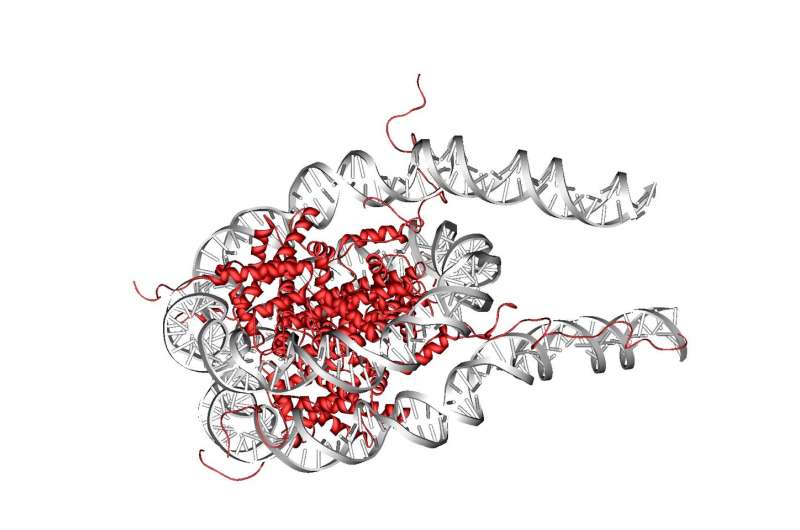Bending DNA costs less energy than assumed

The way DNA folds largely determines which genes are read out. John van Noort and his group have quantified how easily rolled-up DNA parts stack. This costs less energy than previously assumed. Publication in Biophysical Journal.
Every cell contains several meters of DNA, which has to be coiled to fit inside a cell nucleus measuring a few micrometers. Although DNA consists of exactly the same string of billions of letters which encode for proteins, there are many different kinds of cells, such as nerve cells, blood cells or fat cells, each producing a specific combination of proteins. How does a nerve cell know which proteins it needs? And how does it even know that it is a nerve cell? The way DNA folds largely determines which genes are read out. The DNA helix is tightly wound—and therefore poorly readable—on sites with irrelevant code, but it is nicely spread where the useful code resides. John van Noort and his group have studied this process by simulating how easily rolled-up DNA parts—nucleosomes—stack. Stacked nucleosomes are even harder to read out.
The researchers looked at how much energy it costs to bend DNA in between two nucleosomes. Because nature always chooses the path of least resistance, this determines how our DNA is folded. You win energy by stacking nucleosomes, but if it costs more energy to bend the DNA connecting the nucleosomes, it won't happen. Van Noort performed so-called Monte Carlo simulations for three scenarios in which he took neighboring nucleosomes and either stacked them, or made two stacks of odd and even nucleosomes, or completely shut off their interaction. He tried out hundreds of thousands of structures and checked every time whether their shape was energetically more advantageous.
"We have precisely quantified how easily nucleosomes stack," says Van Noort. "We find that bending the DNA between nucleosomes costs less energy than previously assumed, so different structures will form than we thought." Scientists can now use the results to provide their ideas on nucleosome folding with concrete numbers. It enables them to better understand how a cell regulates its genes' activity by folding up DNA. Van Noort: "If in the end we understand in great detail how they manage to do this, we could also recognize where things go wrong in real life. Because DNA folding is such a fundamental process, there are many medical conditions in which this plays a role."
More information: Babette E. de Jong et al. Rigid Basepair Monte Carlo Simulations of One-Start and Two-Start Chromatin Fiber Unfolding by Force, Biophysical Journal (2018). DOI: 10.1016/j.bpj.2018.10.007
Journal information: Biophysical Journal
Provided by Leiden Institute of Physics



















